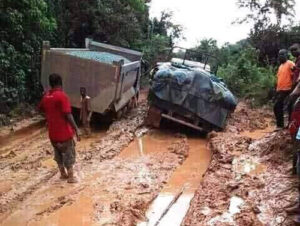
Accra, Ghana//-It is a daily ritual to see young and aged farmers getting down to push vehicles and tricycles transporting their farm produce to the market centres due to poor roads, making prices of foodstuffs very expensive for people to afford.
“We have plenty of foodstuffs in this area. But whenever it rains, the road becomes impassable, making it difficult for us to cart our goods to the market centres to sell”, Kwaku Yeboah, a 65-year-old farmer, lamented.
Mr Yeaboh, who has been a cassava and maize farmer for the greater part of his life, does not believe that the government cares about farmers in the country.
“It is only during electioneering that politicians drive their big cars from Accra to Donkorkrom in the Afram Plains, North of the Eastern Region and other farming communities across the country to canvas for our votes. But after the elections, they don’t deliver on the good roads they promised us”, he added.
While pointing at a muddy and bumpy road, Nana Esi Ama, another farmer, noted: “We farmers are the ones supplying foodstuffs to the people living in the urban areas. However, our roads are very bad”.
Because of the bad roads, we sometimes get involved in road accidents, leading to injuries and destruction of farm produce. Sometimes, some farmers and traders meet their untimely death in their attempt to transport the foodstuffs to feed their compatriots in the urban and peri-urban areas, Opanyin Adu also lamented.
“So, we will hold back food production if the challenges of the poor roads are not addressed on time”, they have threatened.
The above ordeals narrated by the farmers are not unique to them alone. Farmers across the country are facing the same challenges of poor roads in transporting their food commodities to feed the urban people.

The poor road network debacle is not only diversely affecting farmers alone. It is also affecting the traders, mostly market women who travel long distances from the capital city of Accra and other cities in the country to transport the foodstuffs to the cities where markets are available.
Rising food inflation
Coupled with these, as the market women travel over several kilometres to transport the farm produce to the cities, their costs of transportation also go up, which they intend to pass on to the consumers.
This is the reason why Ghana has been recording high food inflation since the outbreak of COVID-19 in March 2020.
For instance, food inflation rose to 61.0% in January 2023, from 59.7% recorded in December 2022, according to the January 2023 Consumer Price Index (CPI) released by the Ghana Statistical Service (GSS).
It also indicated that inflation for locally produced items was 50.0%, while inflation for imported items inched up to 62.5%.
Consequently, the rising food prices pushed the CPI up. Although transport inflation dropped for the first time in several months due to the recent reduction in fuel prices.
However, transport fares of commercial vehicles, which are used by more than 70% of the population, are still very high in the country.
Post-harvest losses
The Head of Food System at the World Food Programme (WFP), Steven Odarteifio, indicated that Ghana loses about $1.9 billion of its crop production to post-harvest losses annually.
He attributed the huge losses to factors including poor road network, lack of processing, and storage facilities, which present and successive governments have done little to address.
What can be done to address the poor roads?
Present and successive governments have prioritised the construction of roads in food-producing areas of the country to ease the burden that farmers, market women and other users go through smoothly.
The ‘Big Push’ agenda involving the roll out $10 billion for rapid infrastructure development to continue the government’s legacy of massive infrastructure development for job creation, Ghana’s Minister of Finance, Dr Cassiel Ato Forson, said.

Also to further ease the transportation of farm products challenge, routine maintenance activities of the Ministry of Roads and Highways comprising grading, pothole patching, shoulder maintenance, and vegetation control were carried out on 21,258.36km of the trunk road network; 10,813km of the feeder road network; and 1,113km of the urban road network in 2024, according to the 2025 budget statement.
In addition, periodic maintenance activities, comprising re-gravelling/spot improvement and resealing works, were carried out on 92km, 321km and 89km of the trunk, feeder and urban road networks, respectively.
The Department of Urban Roads (DUR) undertook 45km of asphalt overlay works in 2024. Additionally, minor rehabilitation works covering upgrading and the construction of culverts and drainage structures were carried out on 519km of trunk roads, 380km of feeder roads and 45km of the urban road network.
“Mr. Speaker, under the Transport Sector Improvement Project (TSIP), the Ministry is piloting the implementation of performance-based road contracting through the rehabilitation and maintenance of about 1,052km of trunk and feeder roads in the Bono East, Northern and Upper West Regions.
The status of these projects are at various stages of completion: Bono East Region- 214km of feeder roads 81 percent complete; Northern Region- rehabilitation of the Tamale – Tatale road, Lot 1 – Tatale – Zabzugu – Yendi Road (66km) 90 percent complete and Lot 2 – Yendi – Tamale (106km) 91 percent; and the rehabilitation of 670km of feeder roads in the Upper West Region”, Dr Ato Forson stated.
As the then Minister for Roads and Highways, Kwesi Amoak-Atta, noted that several roads linking farming communities to the urban areas are being worked on, while others are also being upgraded to make them motorable.
In the 2023 budget document, it stated that the Critical Regional and Inter-Regional Road Projects initiated in 2019 are at various stages of completion.

It mentions that the Upgrading of Golokwati-Wli Road, Nsuta – Beposo, Lot 3, rehabilitation of Nkonya Wrumpong – Kwamikrom, partial reconstruction of Bawjiase – Adeiso, and resealing of Tamale – Salaga Road – Lot have been completed.
Also, progress on Navrongo-Naga, Wa-Bulenga-Yaala; Salaga – Ekumdipe – Kpandai, Kpandai – Nkanchina (10.8km); Atebubu – Kwame Danso; Anwiankwanta – Obuasi; New Abirem – Ofoasekuma; Sefwi Wiawso – Akontombra; and Akrodie – Sayereso roads, among others, have achieved significant progress, the budget statement added.
DRIP machines to the rescue
Recently, Ghana’s Minister for Food and Agriculture, Eric Opoku, said plans were advanced to deploy heavy-duty equipment acquired under the District Road Improvement Programme (DRIP) to commence the construction of farm access roads across the country.
Every district will be supplied with fuel to ensure that the DRIP machinery is put to its intended use — enhancing connectivity between farmlands and nearby communities, according to him.
Mr Opoku added, “What we intend to do is to provide all districts with the financial resources to fuel the machines and use the available equipment to develop access roads. This will make it easier to transport food from farms to communities and urban centres without any difficulty,” he stated.
Bottom line
Indeed, agriculture is a very crucial part of development and poverty reduction in Ghana and other developing countries.
In that regard, agriculture, especially farming activity, depends on good roads for the transportation of the farm produce to the market centres in the urban parts of the country.


